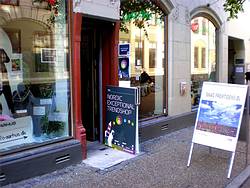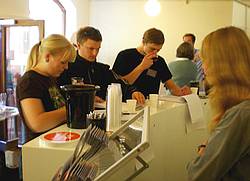All-In-One: An easy sensory consumer test in a natural context


March 2013 - A new easily applied and quickly realizable All-In-One test allows sensory researchers to conduct rapid product tests under natural circumstances using larger consumer groups. This flexible consumer-oriented instrument for sensory evaluation was developed and tested by Danish sensory researchers at the University of Copenhagen.
Sensory analysis tasks have changed over time. Originally, their main purpose was as an instrument of quality control. Today they are an important component of product development and contribute to the understanding of consumer preference. This has had an impact on methodologies. The classic product-oriented approach employs a trained panel of experts to analyze the sensory data; the naïve consumer contributes only to the hedonic assessments. This approach runs the risk that the experts and the consumers could have different evaluations of the same product. Besides this, it requires a strictly controlled test environment that is very artificial when compared to real-life circumstances, since disrupting factors are often completely eliminated. Market researchers doubt that the results that have been obtained under such laboratory circumstances are capable of evaluating the consumers’ true behavior under real-life conditions. They increasingly advocate that tests be conducted under the most natural possible conditions.
A Danish working group under the supervision of Davide Giacalone from the Department of Food Science / Sensory Science at the University of Copenhagen - a member of the European Sensory Network – has developed a comprehensive test that combines a variety of new approaches. With the test, it is possible to collect a large amount of consumer data in a comparatively short time. The test gathers
- demographic information concerning the consumer and his or her personal experiences in relation to the type of test product,
- consumer expectations vis-à-vis an ideal product
- hedonic data on the degree of liking of the actual test product, and
- how the test person describes the products using a list of different descriptors.
This test was first scrutinized using 160 visitors to a Danish culture festival. The researchers invited passers-by to sample six styles of beer. Those that accepted were then given a questionnaire asking for information about themselves (gender, age, education, income level, etc.), as well as their interest and knowledge of beer. In a second step, the participants were asked to complete a CATA list with 27 sensory descriptors (CATA = Check all that apply) that would help them define the characteristics of what they imagined to be the “ideal” beer.
In the sensory part of the test, the researchers served the participants samples of six beer varieties in neutrally-coded glasses. To determine the participant’s perception of how good the beer tasted,a seven-point scale was used for each sample. The participants used the same CATA list of 27 sensory descriptors to check-off the taste nuances and sensory attributes that best described their opinionof how the particular sample tasted. The test took approximately 20 minutes per participant.
Results
The test showed that the consumers found a marked difference between all six beers. Psychographic aspects – especially the individual’s prior knowledge of and interest in beer – indicated a stronger connection to taste preferences than did demographic characteristics. Study leader Davide Giacalone believes that, “Collecting this information seems to be a useful addition to consumer tests, since it affords us a relevant consumer segmentation.”
“Concerning consumer product expectations, we can derive important information from the descriptive profiles of the “ideal” beer, as well as compare these results directly with the consumers’ experiences during the product tasting,” says Giacalone. He goes on to ask, “Do the perceived characteristics correlate with the expectations? Where do they diverge?” As opposed to the traditional approaches, the All-In-One (AI1) test produces a product sensory profile that is directly based on the perceptions of the consumer. Answering concrete CATA questions presents few cognitive challenges to naïve consumers, while it allows them to describe their sensory perceptions.
Thanks to its simplicity and the short amount of time that the test takes, its developer believes it is especially suited for collecting data in a natural setting. The method offers a quick, inexpensive overview of the most important product themes, and the most important product differences from the consumer’s point of view. “It offers the possibility of a quick screening in order to integrate the “voice of the consumer” into the early stages of product development. It is flexible and can be adapted to special questions,” concludes Giacalone. “This instrument is especially suited for early stages of research in which new possibilities need to be identified. It increases the marketing orientation of sensory research.”
Contact:
Davide Giacalone
Copenhagen University
Faculty of Science
Department of Food Science, LMC
Sensory Science
Rolighedsvej 30, 5th floor
DK-1958 Frederiksberg C
Denmark
Source:
All-In-One Test” (AI1): A rapid and easily applicable approach to consumer product testing Davide Giacalone, Wender L.P. Bredie, Michael Bom Frøst
Food Quality and Preference
Volume 27, Issue 2, March 2013, Pages 108–11
Doi: 10.1016/j.foodqual.2012.09.011